8.1 Roadway Marking and Guidance
Retro-reflective markings, delineators, and signs can be a very cost-effective option for assisting a driver. When roadway lighting is not present, nighttime navigation generally depends upon on a road user's visibility of the roadway and pavement markings via vehicle headlamps. These types of systems do not directly help in the visibility of pedestrians, cyclists, or objects on the roadway but can greatly help in guidance and warning of known hazards.
Retro-reflective markings are designed to reflect light back to a road user's eye and improve visibility. High-performance pavement markings have been developed for both wet and dry road conditions.
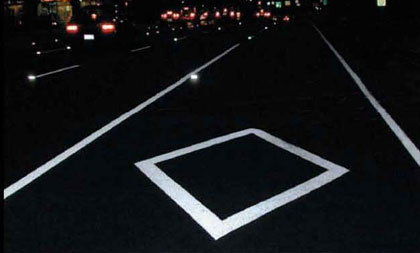
Figure 40 - Retro-Reflective Pavement Markings
Post-mounted delineators (PMDs) are another effective method for providing delineation of roadway curves at night. PMDs consist of retro-reflective strips mounted on posts approximately 1.3 m above the pavement.
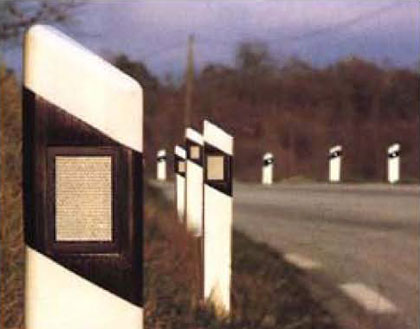
Figure 41 – Post-Mounted Delineators (PMDs)
PMDs are typically used for the benefit of marking out curves in a roadway. The Manual on Uniform Traffic Control Devices (MUTCD, 2009) defines typical spacing for PMDs.
Retro-reflective pavement markings and post-mounted delineators can be considered as alternatives to lighting for rural applications where pedestrians or other unexpected hazards are not anticipated.
8.2 Impact of Vehicle Headlamps
Vehicle headlamps improve a driver's visibility of objects on the roadway. However, this is not well quantified in the research. The effect of headlamps is not currently taken into account when undertaking lighting calculations and designing a roadway system. Typically, at higher speeds, the length of the safe stopping distance exceeds the distance from the vehicle in which headlamps give assistance to the driver.
In order to assess the speeds where headlamps alone may be sufficient, computer modeling was performed (Lutkevich, 2007) using available photometric files for low-beam headlights. The model suggests that vehicle headlamps alone may meet the lighting requirements for low-speed (lower than 30 mph), low-pedestrian-activity roadways. Because this was a limited analysis, however, and because many variables are involved in the decision to provide supplemental lighting, the designer and governing authority must decide whether lighting is warranted. Lighting has been proven as an effective countermeasure but headlamps are a consideration when evaluating a nighttime environment.
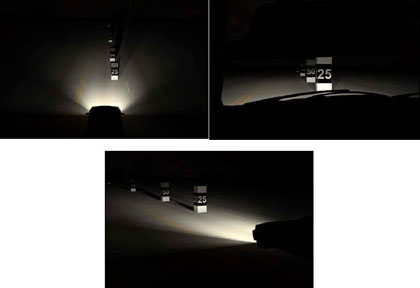
Figure 42 – Headlamp Modeling Example
8.3 Temporary Roadway and Work Zone Lighting
8.3.1 Temporary Roadway Lighting
Temporary roadway lighting is typically installed where a road detour is required. It is provided to aid traffic flow and improve driver and pedestrian visibility during road construction and detours. Temporary roadway lighting levels are similar to the requirements for permanent roadway lighting.
Highway construction projects frequently require detours, reduced shoulder widths, reduced lane widths, limited pull off areas, unusual maneuvering, temporary pavement and markings, rough pavement, and many other conditions that make navigating the construction zone difficult. Temporary roadway lighting can be an effective tool for improving guidance and aiding in the passage of road users through a construction site.
Temporary roadway lighting is considered when one or more of the following conditions are met:
- Where lighting exists but has to be removed for construction, and permanent lighting is not operational.
- The roadway does not meet geometric design standards for an extended period (more than a few weeks).
- Hazards are present during hours of darkness.
- Medium to high pedestrian activity occurs during hours of darkness.
- Devices such as pylons, delineators, barricades and barrels don't provide sufficient guidance.
In the interest of economy, poles and luminaires designated for the permanent installation may be used for the detour and relocated to the permanent location. Highmast lighting is an efficient method of temporary roadway lighting since it lights areas well beyond the roadway, which may be used for temporary detour roads.
8.3.2 Work Zone Lighting
Work zone lighting is provided for construction activities and is not meant to serve as temporary roadway lighting. Work zone lighting typically involves the use of portable, high-intensity floodlights with portable generators to direct a high level of light onto the work area. Because work zone lighting is provided for worker safety, the warrant for this lighting should be dependent on the task at hand and the local worker safety regulations. Work zone illumination levels as recommended by National Cooperative Highway Research Program (NCHRP) Report 498 are recommended.
| Category | Minimum Illuminance Level | Area of Illumination | Application | Example Areas and Activities for Illumination |
|---|---|---|---|---|
| 1 | 54 lux | General illumination through spaces | Large size visual task low accuracy general safety requirements | Excavation; sweeping and cleaning; movement areas in work zones; movement between tasks |
| 2 | 108 lux | General illumination through equipment | Medium size visual task; low to medium contrast; medium accuracy; safety on around equipment | Paving; milling; concrete work around paver, miller and other consruction equipment |
| 3 | 216 lux | Illimination on task | High size visual task; low contrast; high accuracy and fine finish | Crack filling; pot, filling; signalization or similar work requiring extreme caution and attention |
Figure 43 - Work Zone Lighting
Portable lighting equipment can often cause glare issues impacting a driver's visual performance passing through a work zone. To minimize that impact floodlights should be aimed away from travel lanes in a the work zone similar to the recommendation given in Figure 44. The possible addition of temporary roadway lighting may also be evaluated depending on locations and project conditions.
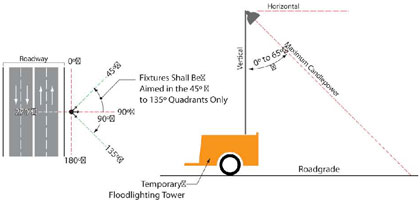
Figure 44 – Work Zone Floodlight Aiming
8.4 Impact of Architectural/Aesthetic Lighting System for Roadway Facilities
Lighting can produce distinctive visual effects, and can help to shape the identity of a place. Poles and luminaries can be provided in custom colors and shapes to complement street furniture such as benches, handrails, and trash bins. Spaces designed for visual effect involving such decorative elements are referred to as "streetscapes."
Typically, street lighting projects involve architects who define the aesthetic elements, including lighting. It is important that the lighting designer work in collaboration with the architect, since lighting features such as pole heights, arm length, luminaire optics, and location all have an impact on the overall design. For example feature lighting in the center island of a roundabout can not only enhance the nighttime aesthetic appearance but also increase vertical luminances on objects possibly enhancing visibility.
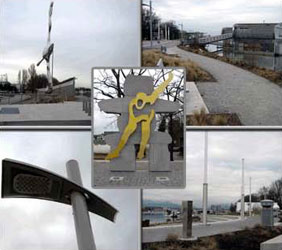
Figure 45 - Streetscape Lighting
Trees and other landscape features may be included as part of a streetscape design. The lighting designer should consult with the architect on items such as the location of plants and trees that may block lighting on the roadway, or tree roots that may interfere with underground conduits or other electrical equipment. Coordination will also be required regarding other architectural elements such as benches, planters, building canopies and awnings, and other street furniture, as well as parking stalls and signage. Architectural requirements should never take precedence over safe lighting requirements.
Streetscape projects are designed to meet both the visibility requirements for drivers and the more subjective security and comfort considerations for pedestrians. To meet sidewalk lighting requirements, pedestrian-scale lighting as shown in Figure 46 is typically be required. For wider roads, or in places where trees are present or proposed, taller poles with mast arms may be required to get lights out on the road.
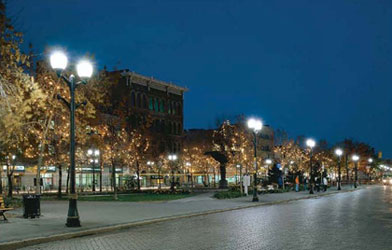
Figure 46 - Pedestrian Scale Lighting
Typical light layouts are shown in Figure 47. For two lane roads, pedestrian-scale lighting may provide the required level of illumination for the street and sidewalk. However, if this does not produce the required results or if the roads are wider (4 or more lanes), pedestrian-scale lighting will typically have to be supplemented with taller overhead lighting poles. The main purpose of the overhead lighting is get the luminaries on mast arms extended over the road beyond to tree canopies to light the street. The pedestrian-scale lighting will provide illumination for the sidewalk.
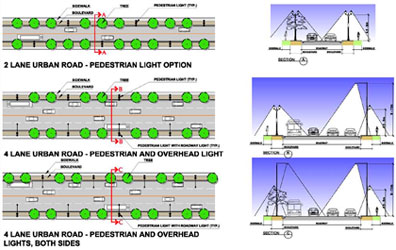
Figure 47 - Streetscape Lighting Layouts
Visibility on the sidewalk and streets can also be reduced if trees block the light and create shadows that reduce uniformity and visibility (Figure 48). A study titled Trees, Lighting and Safety in Context Sensitive Design (24) gave some examples of how a lighting system should be designed to allow for the presence of trees at all stages of maturity:
- The best design approach is to locate luminaires outside of the full growth lines of the species of tree along the roadway.
- When a roadway or pedestrian lighting project includes new or existing trees in close proximity to the lighting, an additional light loss factor should be included in the design to accommodate light loss due to shading. Insufficient research is available at this time to quantify the factor with precision, but an additional 10 - 20 percent is reasonable.
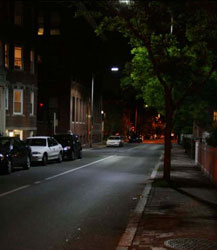
Figure 48 - Trees Blocking Light
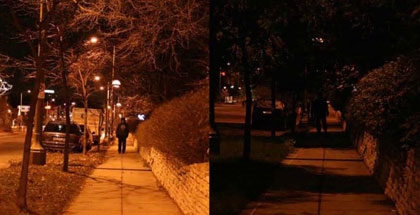
Figure 49 - Comparison of sidewalk areas in winter (without leaves) and summer (with leaves)
